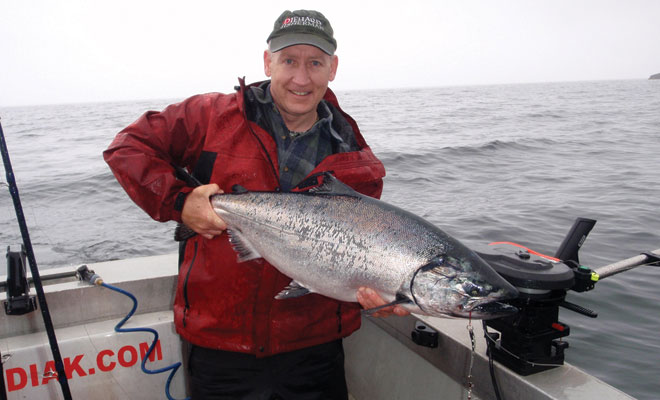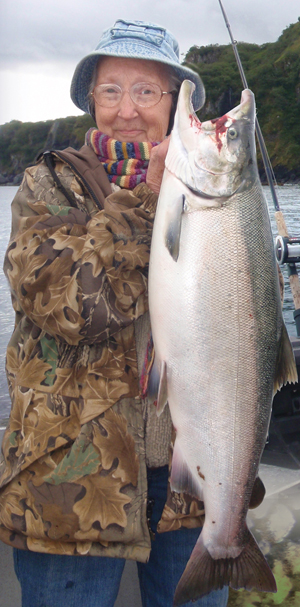
by George Krumm
As I looked out the window of the Era Aviation turboprop I wondered if the rain and wind were going to allow us to fish. It had been iffy for several days, but as I looked down at the sea and coastline it didn’t seem windy at the moment; just rainy. Rick Baker of Fish Kodiak Adventures was waiting for me in the terminal and we discussed the quality and variety of fishing Alaska’s Emerald Island has to offer. I’d fished freshwater streams of the area; Saltery Creek was phenomenal when I fished it for silvers a few years prior, but that was in August. I wondered if there would still be fishable numbers of silvers in the saltchuck, as it was now the second week of September. Rick, however, told me he’d found some fish the previous few days and he was optimistic. This trip was going to be short—I had a day and a half to fish. We needed to find them fast, and Rick did.
Morning dawned overcast, with a light drizzle and no wind. After a breakfast of Rick’s awesome sourdough pancakes, he loaded the boat and prepared it for the short ride to the beach launch on Pasagshak Bay.
As we rode towards the launch, I took stock of the gear we’d be using. The rods were all G. Loomis GL2 1084s fitted with Penn 320 reels, 25-pound P-Line Flouroclear line, and four-inch Fin Fighter spoons in varying colors, all fitted with Gamakatsu 5/0 siwash hooks. Four Scotty electric downriggers stood at the ready.
I began to imagine big silvers ripping across the surface unencumbered by heavy weights or flashers. I was stoked about the gear as it would allow silvers to give us their best. The daily limits in Ugak Bay are five silvers, two kings, two halibut, two lingcod and five rockfish. Talk about opportunity!
Rick uses an old Army deuce-and-a half to launch his boat. The varying condition of the beach makes launching a large boat with a standard pickup risky but the deuce-and-a-half makes launching and retrieving the boat a non-event. With the boat in the water, Rick, Jeff Slaughter and Louisa Villarreal of Andrew Airways, George and Harriet Schoppert from Oregon, and I were soon skimming across calm seas heading towards Ugak Bay.
Rick motored to an area at which he’d been finding silvers and began to troll along the path of his GPS history from the previous trip. With an eye on the sonar and an eye on the surface looking for jumping coho, he retraced the route. We had lures at staggered depths between 20- and 50 feet. It rained steadily, but we all stood out on the deck in anticipation of the chaotic action that sometimes occurs when pursuing silvers in the ocean. Unfortunately, this area that produced so well the previous few days seemed devoid of fish. One other boat was in sight, but as far as I could tell they didn’t hook up in the 20 minutes or so that we were near them. Rick pointed the bow northwest after seeing a few fish jump far away in that direction.
A quarter-mile later we began to see fish and bait balls on the sonar and silvers occasionally slashing through the surface. The rear, port downrigger rod bounced and then snapped skyward as a fish hit the spoon. It was go time! Louisa grabbed the rod as 12 pounds of chrome erupted from the water 40 feet behind the boat. Rick had slowed the boat, and almost immediately two of the other rods went off.
Coho chaos ensued, with the three salmon going in different directions and three anglers doing an unrehearsedballet on the deck trying to keep lines from tangling. One fish came undone, but two beautiful silvers went into the shave ice in the fish boxes. Once the fish were dispatched, we put the lines back down and Rick turned the boat in the direction of the school. I’d like to give a complete blow-by-blow description of what happened over the next hour and a half, but the action was so fast and furious there wasn’t much time to think about it. Multiple, simultaneous hookups were the rule; it didn’t happen often that we hooked singles. On this day the fish seemed to average 13- or 14 pounds with some larger, some smaller.
Though we were fishing in water that varied from 75- to 300 feet deep and we were for the most part fishing well off the bottom, we still caught a few small halibut and a ling or two. Rick said he caught much larger halibut earlier in the summer fishing in similar fashion.
After the tide changed, fishing slowed. Rick suggested dropping one of the lines down to 66 feet as he was seeing some fish on sonar at that level. Jeff and I thought a black and white Fin Fighter with a glow herringbone pattern on it would show up well at that depth, so that’s the lure we dropped. It wasn’t long before that rod snapped to attention and then doubled over under the weight of a good fish. Jeff grabbed the rod. A few minutes into the battle we saw he’d hooked a king in the 20-pound class. That fish got off, but we now knew there were a few kings around so we dropped two rods down to 66 feet, both with the black/white/glow herringbone pattern spoons. A few minutes later another king chomped down on the spoon, and this time Jeff landed it. We ended up boating three kings, the largest of which was pushing 30 pounds. The girth on these fish was impressive. Rick has caught kings to 72 pounds in the Ugak Bay area. He mentioned that big kings are available year-round, though the best fishing for really big hawgs is May and June.
As the day wore on we picked up a few more silvers here and there, finishing the day with 23 silvers, three kings, three halibut, a ling and a couple rockfish. Two of the three kings turned out to be white kings, considered by many to be even more of a delicacy than the usual, already great-tasting kings. As we rode back towards the launch, I marveled at the beauty of Kodiak Island and the productivity and diversity of its fishing. It was spectacular in every way.
When we got back Rick and company went to work filleting the day’s catch, while his wife Leslee vacuum-packed. We then sat down to a wonderful dinner, the highlight of which was bison, broiled to perfection along with coconut-fried halibut, stuffed baked potatoes, soup, salad, bread, the works. Afterwards, several of us made a trip to the banya, a large, wood-walled sauna. I felt completely spoiled and pampered. To say I slept well that night is an understatement.
Small-craft advisories were issued for day two, and we’d decided we wouldn’t fish that day. However, upon awakening, the sky was partly cloudy, with little wind. Rick, not being the kind to pass up an opportunity, made the call that we could head out for a few hours and still get me to the airport on time. Since we weren’t planning on fishing this day, we’d gotten up later and we missed the tide that produced so well for us the day before.

An hour or so later we moved, fishing shallower water near the cliffs and the beach, hoping to find a few kings. We didn’t locate any, and with time running short Rick made a run to an offshore pinnacle he said would produce large black rockfish. We rigged the rods with six-ounce metal slab jigs and dropped them down near the top of the hump. It was almost impossible to get to the bottom—four- to eight-pound black rockfish hit the offerings before the jigs could reach bottom. We all had fish on immediately.
Wind and tide moved us off of the pinnacle in just a few minutes so Rick had us reel in and he repositioned the boat. We quickly boated several more rockfish and then called it a day. When we got back, Rick made short work of the fish while I took a shower and packed my gear for the flight back to Anchorage. Rick and Leslee packed a box of fish for me, and when I got home, I was pleasantly surprised to see he’d given me what turned out to be 12 pints of silver eggs and several Fin Fighter spoons in addition to my salmon and halibut. I’d mentioned that I could use some eggs, and that I thought the spoons would work to jig for big lake trout through the ice this winter. That’s testimony to Rick’s thoughtfulness. He also gave me some of his sourdough starter, of which my family and I have become quite fond.
This trip opened my eyes to the richness of Kodiak’s saltwater fishery. Though it was late in the season, in a short day and a half I caught five species of fish (silvers, kings, halibut, lings and black rockfish) and left with roughly 50 pounds of expertly vacuum-packed, succulent fillets. The fishing, the accommodations, the hospitality, the food, the scenery and the experience were all first-rate.
The silvers were large, and the unexpected appearance of kings from 20- to 30 pounds was fantastic. I wish I had more time, so naturally, I can’t wait to visit again.
George Krumm has been fishing Alaska since 1994 and has written for Fish Alaska magazine since 2003. He’s a contributing editor for the magazine and writes the Stillwater Strategies column. He can be reached at george@fishalaskamagazine.com.
This article originally appeared in the January 2013 issue of Fish Alaska.
